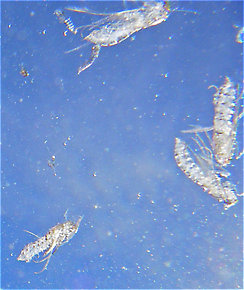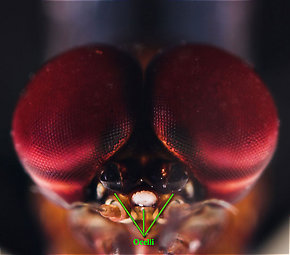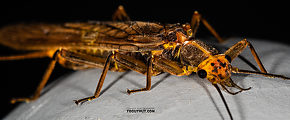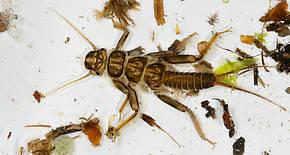Blog & Latest Updates
Fly Fishing Articles
Insects by Common Name


Western Stoneflies
This common name refers to only one species.
Stonefly Species Calineuria californica
These are sometimes called Western Stoneflies.
Calineuria californica is the largest western species of the Perlidae family, with female adults approaching 40 mm in some locales. This species is perhaps better known by anglers under its former scientific name, Acroneuria californica. It is the primary Golden Stonefly hatch of the West Coast states, a role shared by Hesperoperla pacifica to a lesser degree. Their roles are reversed in the Rocky Mountain states where pacifica takes the top billing. Both are now commonly known as Golden Stones as regional colloquial differences have slowly dissipated. They were both commonly called Brown Willowflies in the Rockies and Golden Stones in the coastal states, which explains the confusion caused by references in older fly fishing literature.
This large stonefly is ubiquitous in western freestones and can provide incredible angling at ther height of their activity. On rivers lacking populations of Pteronarcys californica, they are the largest and most significant hatch of the year. They are generally a late spring/early summer emerger. They crawl out of the water to perch on streamside riparian foliage or rocks where they shed their nymphal shucks ( Shuck: The shed exoskeleton left over when an insect molts into its next stage or instar. Most often it describes the last nymphal or pupal skin exited during emergence into a winged adult.). They also mate in the same locations. The females end up back on the water in good numbers and offer good dry fly fishing. But it is the nymphs that offer the best angling opportunities, especially as they stage in the shallows in preparation for emergence.
Shuck: The shed exoskeleton left over when an insect molts into its next stage or instar. Most often it describes the last nymphal or pupal skin exited during emergence into a winged adult.). They also mate in the same locations. The females end up back on the water in good numbers and offer good dry fly fishing. But it is the nymphs that offer the best angling opportunities, especially as they stage in the shallows in preparation for emergence.
The nymphs lack anal gills which easily separates them from Hesperoperla and Claassenia. Their lateral (Lateral: To the side.) ocelli ( Ocellus: A simple non-compound, single lens eye found in many arthropods. Mayflies have three ocelli in between their compound eyes.) (simple eyes) in a pale background separates them from Doroneuria.
Ocellus: A simple non-compound, single lens eye found in many arthropods. Mayflies have three ocelli in between their compound eyes.) (simple eyes) in a pale background separates them from Doroneuria.
The male adults of Calineuria and Hesperoperla are easy to tell apart by looking at their hammers (Hammer: A smooth clearly defined chitinous area on the ventral surface of the ninth abdominal segment of some male stoneflies used for drumming up mates.). Both are quadrangular but Calineuria is longer than wide. The heads and pronotums of both sexes are dramatically marked in Calineuria while Hesperoperla is more plain.
This large stonefly is ubiquitous in western freestones and can provide incredible angling at ther height of their activity. On rivers lacking populations of Pteronarcys californica, they are the largest and most significant hatch of the year. They are generally a late spring/early summer emerger. They crawl out of the water to perch on streamside riparian foliage or rocks where they shed their nymphal shucks (

Here's an underwater view of the pupal shucks of several already-emerged Brachycentrus numerosus caddisflies.
The nymphs lack anal gills which easily separates them from Hesperoperla and Claassenia. Their lateral (Lateral: To the side.) ocelli (

The ocelli of a male Isonychia bicolor mayfly spinner.
The male adults of Calineuria and Hesperoperla are easy to tell apart by looking at their hammers (Hammer: A smooth clearly defined chitinous area on the ventral surface of the ninth abdominal segment of some male stoneflies used for drumming up mates.). Both are quadrangular but Calineuria is longer than wide. The heads and pronotums of both sexes are dramatically marked in Calineuria while Hesperoperla is more plain.
Female Calineuria californica (Golden Stone) Stonefly Adult View 17 PicturesI caught this female in the vegetation on a trail about 50 feet above the stream. The coloration on its head differs from that of a male I collected recently on a nearby river, and from another female I collected on the same river. But it still keys out confidently to Calineuria, and californica is the only species of that genus in the area.
View 17 PicturesI caught this female in the vegetation on a trail about 50 feet above the stream. The coloration on its head differs from that of a male I collected recently on a nearby river, and from another female I collected on the same river. But it still keys out confidently to Calineuria, and californica is the only species of that genus in the area.
 View 17 PicturesI caught this female in the vegetation on a trail about 50 feet above the stream. The coloration on its head differs from that of a male I collected recently on a nearby river, and from another female I collected on the same river. But it still keys out confidently to Calineuria, and californica is the only species of that genus in the area.
View 17 PicturesI caught this female in the vegetation on a trail about 50 feet above the stream. The coloration on its head differs from that of a male I collected recently on a nearby river, and from another female I collected on the same river. But it still keys out confidently to Calineuria, and californica is the only species of that genus in the area.See 2 more specimens...
Top 10 Fly Hatches
Top Gift Shop Designs
Eat mayflies.
Top Insect Specimens
Miscellaneous Sites
Troutnut.com is copyright © 2004-2024 Jason
Neuswanger (email Jason). See my FAQ for information about use of my images.
 privacy policy
privacy policy

